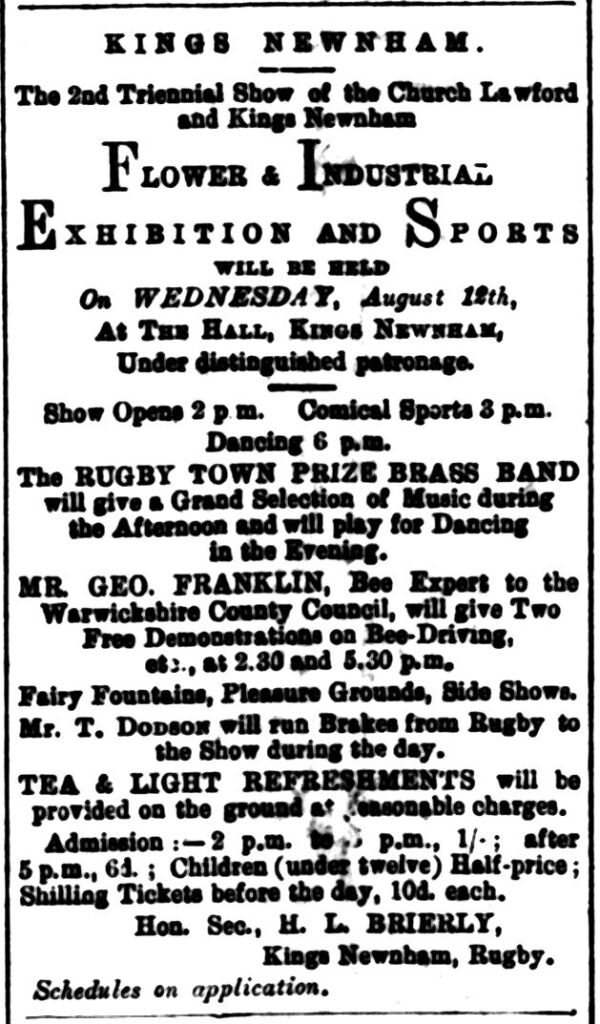The Village Fete has been a fixture in the village for many years. It might be regarded as a successor to either the May Parade or the Village Flower and Produce show, with perhaps the latter being the most appropriate root.
The King’s Newnham and Church Lawford Triennial Show began in 1900, known as the “Flower Show and Industrial Exhibition” and as the name suggests it was to be held every three years, and featured village crafts as well as garden produce.
The reports of each of the five pre-First World War Shows in the Rugby Advertiser or one of its sister papers such as the Kenilworth Advertiser were tremendously detailed, reflecting the interest in the show. The initia; part of the report for the first show in 1900 was as follows :
Gratifying success attended a flower and industrial exhibition, coupled with athletic sports, held at the Hall, King’s Newnham, on Wednesday. The show, which was the first of its kind, was promoted chiefly for the benefit of the residents of Church Lawford and King’s Newnham, to whom most of the classes were restricted. It was a delightful afternoon, sunny and warm-almost ideal in fact-and the number of visitors from Rugby and neighbouring places who entered Mr J Brierly’s prettily-situated grounds and gardens, the latter being resplendent with flowers in charming profusion, must have been encouraging to the promoters, and should inspire them to arrange for similar holidays in the future.
The ideas originated with the Rev S W Frost, the rector of the parish. He conferred with Mr T Riddell and several other leading residents, and the upshot was that a meeting of those principally concerned was convened. The undertaking commended itself to the parishioners who attended, many of whom have worked energetically to ensure its success, and, thanks to the labours of committees for the different departments, a remarkably interesting collection of exhibits, embracing quite a variety of subjects, was obtained, including not merely horticultural produce, but needlework, confectionery, paintings, poultry, baskets, working models, &c. Indeed, the variety of the exhibition was one of its salient features. Beginning with the industrial section, the visitor found a capital assortment of needlework. That for which cottagers were responsible was praiseworthy, although, as was only to be expected, the articles would not compare with the best of those to be seen in the amateurs’ division. To comment upon everything that was good would be impossible, but in the open class there was really a nice lot of cakes; and the paintings and etchings, if not up to academy standard, were at all events interesting. as were the exhibits in the class for working models.
A class for the best shilling supper for four persons brought out a strong competition, from which the visitor was able to pick up useful hints as to the economical production of an excellent repast The first prize supper was particularly inviting. Considering the limits of the show, the display of horticultural produce was better than might have been expected. Mr T Daniels’ (Thurlaston) prize tray of vegetables was unusually fine, and the same exhibitor sent collection of cut flowers that would have taken some besting anywhere. For the time of the year the roses were fairly good, and of fruit the collections were excellent. Children contributed their quota to the interest of the exhibition. To have secured such beautiful bouquets of wild flowers and grasses, some of them must have searched the meadows and lanes industriously, whilst the entries of wild fruit were, if anything, more remarkable still. Blackberries, crab apples, nuts, elderberries, sloes, hips, acorns, haws, barberries, and other varieties were found on the winning trays. Mr F Whiteman showed a curious fern of the “monkey tree ” variety that was deservedly placed first in the class for window plants.
The full report for this show, as well as the reports for subsequent shows, can be found via the links in the following table.

This show was to continue through to the 1930s, becoming an annual horticultural show, moving to the Reading Room in Church Lawford in later years. There was also competition from the Potato Show, organised by the owners of the White Lion – detailed here, After the Second World War the gathering became known as the Church Fete or the Village Garden Fete, and was initially held in the gardens of the Rectory, before being held on the Glebe Field at the top of King’s Newnham Road in Church Lawford on many occasions.
A report on the annual flower show in 1935 is here.
A Report on Potato Shows during the inter-war period is here.
Such shows were suspended during the period of the Second World War, and after that war the Flower Show was not restarted, with the balance of funds being used to help fund the provision of a bus shelter. confirmed in the Parish Council Minutes in 1948.
A Report on the 1951 Fete is here, and the 1955 Fete is here.
A report on the 1948 Fete is below.

In 1991 the villages staged a May Fayre and Flower Festival, which proved very successful, both in financial and social terms.
